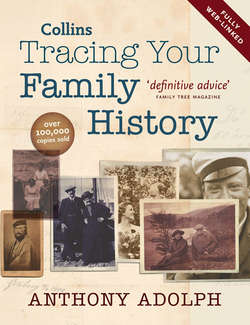Читать книгу Collins Tracing Your Family History - Ryan Tubridy, Anthony Adolph - Страница 147
ОглавлениеCHAPTER SEVEN THE MAIN WEBSITES
The internet has not created any new genealogical records, but it has made some of them much more readily accessible than before. The plethora of sites out there can be very confusing, not least because a lot of data is duplicated.
ORIGINAL DATA
The records that you can use for tracing your family tree are clearly described in this book. Increasingly, the most useful ones are being indexed, digitised, and made available on CD-Rom and the internet. Besides producing datasets from original records, the internet sites will often license the use of their data elsewhere.
This is all to the good, but it can make life very confusing for first-time genealogists, though nobody now can keep pace with the number of different sites, and the way many of them change. Equally, there is no duplication-free way of navigating through these sites. Which of them represents the best value really depends on your individual case – one site may contain vastly more useful information for one person than it does for another. I can only advise you to have a quick look at them all once in a while to see what they have got, what they cost and what new material they have added.
Remember, all of these sites have come into existence in the last few years, many duplicate each other, and none have access to esoteric data that could not be searched in the archives described in this book. Sites like Genes Reunited, however, that include private individuals’ own knowledge may be unique in providing you with a channel to finding it.
When using sites that contain information supplied by private researchers (like you), either as details of what they know, or in the form of queries, be cautious. None of the information should be taken at face value – it could be wrong. It can, however, be used as a basis for your own research: question it, check it, and if it is correct, build on it – and make some new friends into the bargain.
NEW SITES
Two recent sites facilitate searches in a group of otherwise unrelated websites.
www.nationalarchives.gov.uk/search
enables a single search covering TNA’s catalogue, DocumentsOnline, A2A, Moving Here, some family records websites, the NRA and ARCHON.
www.surnamenavigator.org
enables a single search covering the Mormon Databases, Google Genealogy, Google News Genealogy, Google Press, Rootsweb All Databases, Geneanet, Cemetery Transcriptions, Ancestry.com, Author Profile Usenet, MSN Member Directory, Gencircles, Global Tree (part of GenCircles) and Genealogy Locator.
QUICK REFERENCE
See Here.
SUPPLIERS
www.archivecdbooks.org. CDs containing censuses, some parish registers and many books useful for references, old copies of Burke’s Peerage, university registers and much more.
www.eneclann.ie. Eneclann owns Archive CD Books (Ireland) and produces much useful Irish material on CD.
www.genealogysupplies.com. S&N Genealogy’s site, which sells software, books, census CDs and storage facilities.
www.memories-nostalgia.com/products.htm. Watermans’ family history storage boxes.
www.my-history.co.uk. Sells genealogy supplies including folders, books, computer programs, and census CDs but these are largely superseded by online searches.
RECORDS AND CONTACT
www.ancestry.co.uk. This site was the first to bring full access to the indexed censuses, 1841–1901, and has the complete quarterly indexes to General Registration. It contains many other indexes such as the Pallot Indexes (see here) and indexes to TNA’s First World War pension records (WO 363, and it should soon include WO 364). There are also many indexed and scanned books, from Genealogical Gleanings in England to various publications of Burke, and even sections from Ruvigny’s Blood Royal. Its American parent site, www.ancestry.com, contains the Ancestry World Tree, which is similar to GenCircle’s Global Tree and to Genes Reunited, whereby you enter details of your family tree and see if anyone else out there has been researching the same ancestors.
www.curiousfox.com. Message boards arranged by place for Britain and Ireland, enabling you to contact other people researching families from your ancestral homes – a very good idea!
www.familyrelatives.com. The quarterly General Registration indexes (which, uniquely, are fully indexed for the years 1866–1920), with the added facility of being able to leave a message against entries relating to your ancestors, so as to facilitate contact with other researchers with the same forbears. They also have some datasets drawn from army records and parish registers.
www.findmypast.org. Has the quarterly General Registration indexes and all the subsidiary ones, such as consular and army births, marriages and deaths, the censuses 1841–1891, death duty registers 1796–1903 and a growing number of other useful datasets, such as various published military records and passport applications 1851–1903. It also includes the many indexes of the FFHS member family history societies, some compiled decades ago, formerly at www.familyhistoryonline.net.
www.genesreunited.co.uk. The foremost British-based genealogical contact website. See here.
http://genforum.genealogy.com. Message boards offering a question-and-answer facility for most surnames and many genealogical topics.
www.nationalarchives.gov.uk/documentsonline. Documents online-indexes and makes available images of documents at TNA. At the time of writing, the main ones include: First World War Campaign Medals, Second World War Seamen’s Medals, Prerogative Court of Canterbury wills; Death Duty registers; Victorian Prisoners Photograph Albums; Registers of Seamen’s Services; Women’s Army Auxiliary Corps; First World War Prisoners of War Interviews; Royal Naval Division (1914–1919); Victoria Cross Registers; Recommendations for Honours and Awards (Army); Ancient Petitions, Henry III – James I; Poor Law Union Correspondence; Aliens Registration Cards; Domesday Book.
